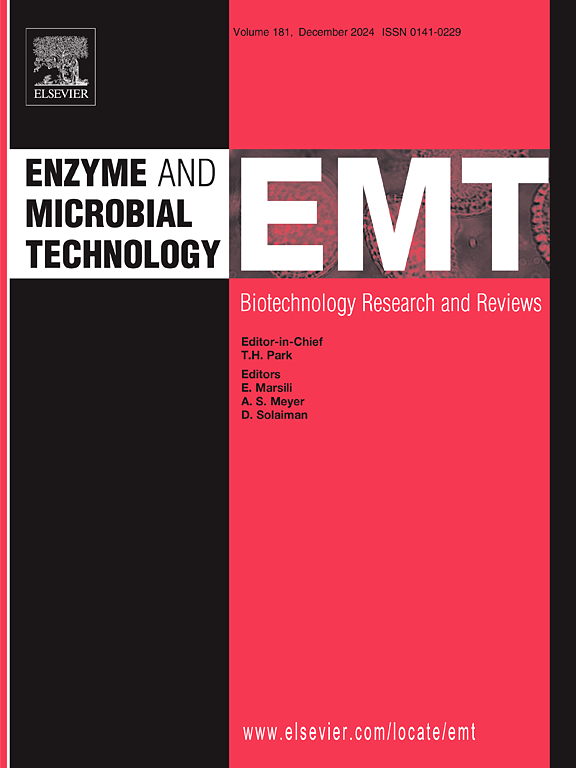假单胞菌降解龙脑和樟脑途径的代谢工程,以生产光学纯双环单萜烯。
IF 3.4
3区 生物学
Q2 BIOTECHNOLOGY & APPLIED MICROBIOLOGY
引用次数: 0
摘要
莰烯醇是一种具有重要药用价值的双环单萜,可促进药物通过粘膜和血脑屏障的转运。莰烯醇和樟脑的衍生物也有许多生物医学应用。莰烯醇目前是通过松节油和 α-蒎烯的转化进行工业合成的。不过,主要产品是外消旋异龙脑,而不是外消旋莰烯。莰烯醇和异龙脑都能被土壤中的假单胞菌通过一种成熟的降解途径降解。两种本地假单胞菌株被用来将外消旋异龙脑转化为其他光学纯双环单萜烯。结果表明,仅从 TCU-HL1 菌株基因组中删除 camE2,5 基因就会导致其完全丧失降解龙脑和樟脑的能力。同时敲除 camE2,5 和 bdh1(TCU-HL1Δbdh1ΔcamE2,5)可恢复降解能力,因为 Bdh1 的作用被 Bdh2 所取代。该突变体将外消旋异龙脑转化为光学纯双环单萜烯,即 2,5-二酮樟脑,回收率为 45%。RT-qPCR 结果表明,camE2,5 的表达在调节龙脑醇/樟脑降解簇中起着关键作用。虽然(+)-冰片醇、(-)-冰片醇和(+)-樟脑可以从植物中获取,用于大规模生产,但(-)-樟脑却不能以同样的方式获取。P. monteilii TCU-CK1 能将外消旋异龙脑转化为(-)-樟脑和 3,6-二酮樟烷,回收率分别为 15 % 和 10 %。总之,我们报告了 camE2,5 在调节龙脑醇/樟脑降解操作子和生物转化方法以生产多种光学纯双环单萜烯中的作用。本文章由计算机程序翻译,如有差异,请以英文原文为准。
Metabolic engineering of the borneol and camphor degradation pathways in Pseudomonas to produce optically pure bicyclic monoterpenes
Borneol, a medicinally important bicyclic monoterpene, facilitates drug transport across mucous membranes and the blood-brain barrier. Derivatives of borneol and camphor also have numerous biomedical applications. Borneol is currently industrially synthesized via the conversion of turpentine and α-pinene. However, the major product is racemic isoborneol rather than racemic borneol. Both borneol and isoborneol are degraded by the soil bacterium Pseudomonas via a well-established degradation pathway. Two indigenous Pseudomonas strains were used to convert racemic isoborneol to other optically pure bicyclic monoterpenes here. Our results showed that deletion of the camE2,5 gene alone from the strain TCU-HL1 genome led to the complete loss of borneol and camphor degradation ability. Knockout of both camE2,5 and bdh1 (TCU-HL1Δbdh1ΔcamE2,5) restored the degradation capability as the role of Bdh1 was replaced by that of Bdh2. This mutant converted racemic isoborneol into an optically pure bicyclic monoterpene, 2,5-diketocamphane, with a 45 % recovery yield. RT-qPCR results suggested that camE2,5 expression plays a pivotal role in regulating the borneol/camphor degradation cluster. While (+)-borneol, (–)-borneol and (+)-camphor can be obtained from plants for mass production purposes, (–)-camphor cannot be obtained in the same manner. P. monteilii TCU-CK1 converted racemic isoborneol into (–)-camphor and 3,6-diketocamphane, with 15 % and 10 % recovery yields, respectively. In conclusion, we report the role of camE2,5 in regulating the borneol/camphor degradation operon and biotransformation methods to produce several optically pure bicyclic monoterpenes.
求助全文
通过发布文献求助,成功后即可免费获取论文全文。
去求助
来源期刊

Enzyme and Microbial Technology
生物-生物工程与应用微生物
CiteScore
7.60
自引率
5.90%
发文量
142
审稿时长
38 days
期刊介绍:
Enzyme and Microbial Technology is an international, peer-reviewed journal publishing original research and reviews, of biotechnological significance and novelty, on basic and applied aspects of the science and technology of processes involving the use of enzymes, micro-organisms, animal cells and plant cells.
We especially encourage submissions on:
Biocatalysis and the use of Directed Evolution in Synthetic Biology and Biotechnology
Biotechnological Production of New Bioactive Molecules, Biomaterials, Biopharmaceuticals, and Biofuels
New Imaging Techniques and Biosensors, especially as applicable to Healthcare and Systems Biology
New Biotechnological Approaches in Genomics, Proteomics and Metabolomics
Metabolic Engineering, Biomolecular Engineering and Nanobiotechnology
Manuscripts which report isolation, purification, immobilization or utilization of organisms or enzymes which are already well-described in the literature are not suitable for publication in EMT, unless their primary purpose is to report significant new findings or approaches which are of broad biotechnological importance. Similarly, manuscripts which report optimization studies on well-established processes are inappropriate. EMT does not accept papers dealing with mathematical modeling unless they report significant, new experimental data.
 求助内容:
求助内容: 应助结果提醒方式:
应助结果提醒方式:


